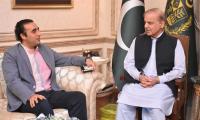ISLAMABAD: Almost 80 percent private sector consumption contributed towards Pakistan’s GDP growth rate, then followed by public sector consumption that contributed just 13 percent per annum for achieving growth momentum.
IPSOS, a global research firm, conducted a study on macro and micro economic issues of Pakistan’s economy under supervision of former finance minister and renowned economist Dr Hafeez A Pasha. According to Dr Pasha, other major drivers of country’s growth with contribution of private investment of 12 percent, public investment 4 percent, exports 9 percent and imports 17 percent.
Broadly speaking, the research study finds out that approximately 20 percent of the GDP is generated from agriculture, another 20 percent from industry and the remaining part, 60 percent, by services.
The largest sector in the economy is the domestic Wholesale and Retail Trade sector, with a share of 18 percent. The share of manufacturing and services, especially trade, finance and transport, is rising.
The largest expenditure component in the GDP is private consumption expenditure with a share approaching 80 percent. Thesize of the government sector is moderate at 25 percent. Efforts are being made to increase the share of exports in the national economy. Pakistan has been successful in achieving inclusive growth. Income inequality has been declining over the last decade. Consequently, the ratio of the income share of the top quintile verses the bottom quintile at 4.8 in 2018-19 is low by international standards.
As highlighted earlier, services play a dominant role in the economy of Pakistan, with a share in the GDP of over 60 percent. The largest service is domestic wholesale and retail trade, with over 18 percent of the GDP being created by this sector. It employs almost 8.5 million workers currently and generates incomes equivalent to $52 billion. The other large sectors are transport and communications, education, health and services with employment of 2.8, 2.1 and 0.7 million workers respectively.
The sectors which have shown the greatest dynamism since 2009-10 are information and communications, accommodation and food services, health, arts and entertainment, education and transportation. All these sectors have the potential for attracting foreign direct investment.
The information and communications sector and accommodation and food services have witnessed exceptionally high growth rates of 11 percent and 8.5 percent respectively. They have already witnessed sizeable entry of multinational companies. There is potential for foreign universities to set up campuses in Pakistan in view of the growing demand for higher education in the country.
The process of growth originates through value added activities in the economy which increase household incomes and spillover into higher demand for goods and services. The sale at the retail level of FMCG (Fast Moving Consumer Goods) hinges crucially on the buoyancy of this growth process.
The fundamental question is what has determined the relatively rapid growth in private consumption spending in Pakistan? It has grown at over 4 percent in the face of GDP growth rate of somewhat less. Econometric analysis of relevant data from the early 90s reveals the extent of contribution of different growth drivers to consumer spending (see Chart 13). Clearly, the biggest contribution of 61 percent is by the growth of real incomes.
However, there are some special factors in the Pakistani context. First, the rapid growth in home remittances to families in Pakistan has contributed 15 percent. Second, of significance is that Pakistan has witnessed falling income inequality and this has led to greater participation by the lower and middle income groups in retail buying. This role has not been highlighted before. Also, a nominally stable exchange rate from 2014-15 to 2017-18 increased the affordability of imported goods.
The impact of rising consumer spending has created buoyancy in the retail sector of the economy. For example, as shown in Chart 14, the peak growth rate in consumer spending of 8.5 percent was witnessed in 2016-17. This led to a high increase of 7.5 percent in the volume of domestic trade.
An in-depth analysis has been undertaken from the data in Household Survey carried out by the Pakistan Bureau of Statistics in 2018-19. The new finding is that the lower income segment of the market for FMCGs has been substantially more buoyant than the top income consumers. This should have major implications for future product development, marketing and advertising strategies (see Table 2).
The two comparable markets are the two other major economies of South Asia, namely, Bangladesh and India. India has the highest per capita income, followed by Pakistan and Bangladesh (See Table 3).
Both India and Bangladesh have achieved significantly higher GDP growth rates than Pakistan during the last decade. A large driver has been export-led growth. These two countries have also managed to control the size of their trade and current account deficits. Bangladesh has also been able to keep the budget deficit at comparatively low level.
The lessons to be learnt are the need to focus on growth and diversification of exports as the primary driver of growth. India has also managed to raise agricultural productivity primarily through a large outlay on input subsidies. The export incentive regime of Bangladesh of cash payments on top of export receipts has also worked well.
The great and perhaps unexpected finding is that a through Pakistan has achieved less growth it has managed to pursue a path of more inclusive development.
Pakistan has significantly less income inequality than India and Bangladesh. Both these estimates are experiencing rising inequality while it continues to fall in Pakistan. This has implication for the development of the market for FMCG as highlighted earlier, the report concluded.
Pak Army and Gilgit-Baltistan government request federal government to provide 100pc local wheat
More than $20bn in market value has been wiped off Adani’s corporate empire, says Financial Times
Fund asked government to increase sales tax on POL products to 18 percent instead of 1-2 percent.
Air chief’s visit underscores importance of technological collaboration in strengthening national defence capabilities
Under Article 154 of the Constitution, it is mandatory to hold a CCI meeting every 90 days, says Sindh CM
Chairing meeting on Thursday, CM directs construction of 5,000 new classrooms under PSRP Programme







